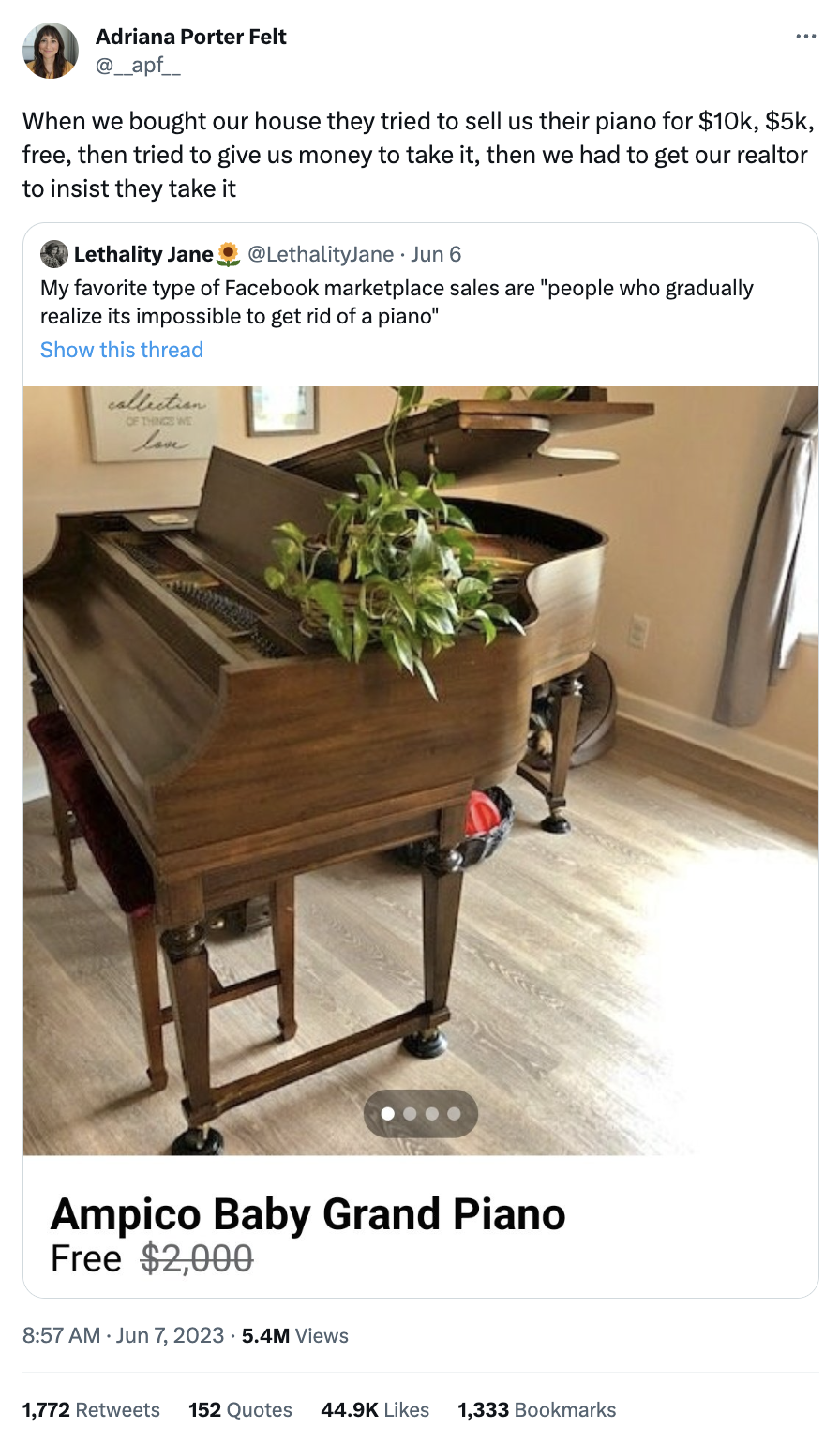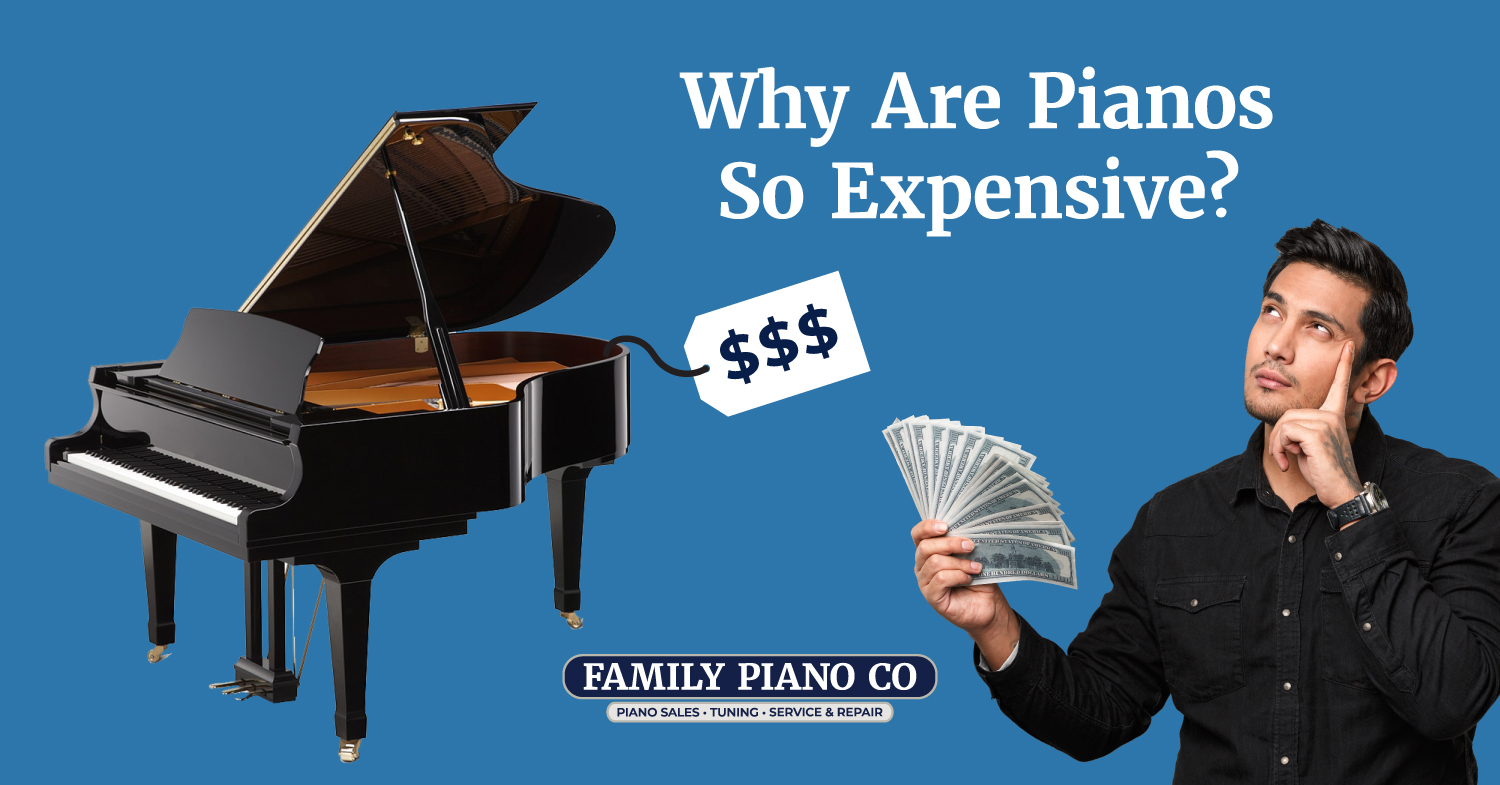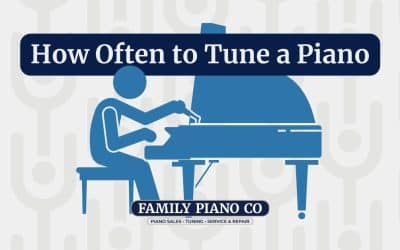Most acoustic pianos made for homes cost around $600 – $20,000. While that’s far from the most expensive $3 million pianos, this is still a pretty wide range — especially compared to other instruments like guitars. Which begs the question here today: why are pianos so expensive?
Well for one, a piano is a complicated instrument with a ton of tiny moving parts. Making one is thus no simple task, each one being handcrafted to some extent before being assembled with big expensive machines. Then, they’re often shipped halfway across the world and marketed for sale! Every piano is a marvel of engineering really!
There are many factors that’ll influence the upfront cost of any piano. In this blog post, we’ll give you a quick rundown of the most significant ones so we can answer this question with some detail.
Brand
This probably isn’t a surprise, but the brand of a piano has one of the most significant impacts on its price.
Some of the most renowned and respected piano brands, such as Steinway & Sons, Bechstein or Bösendorfer, all offer high-quality instruments that command a high price due to their reputation.
Steinway & Sons particularly is one of the most expensive American manufacturers of all time. Even their Model S 5’1 Baby Grand piano starts at $70,000 brand new! The similarly-sized Kawai GL-10 5’0 Baby Grand piano instead starts at $18,000 — basically a quarter of the cost!
Check out one of our more popular articles, where we go into more detail on Kawai vs Steinway pianos.
We urge anyone buying a piano not to automatically shop by brand. While there are genuine reasons why a piano could cost so much, you do need to consider you’re paying for the company’s marketing. And just because a piano costs twice as much does not necessarily mean it’s twice as good!
Grands vs Uprights
If shopping for an acoustic piano, you’re going to be choosing between an upright or a grand.
New prices for a grand range from $12,000 to over $100,000 making them the most expensive type of piano. They’re the largest pianos available (which means best feel and sound potentially), and they boast an elegant construction with high-quality materials in most cases.
Upright pianos are generally less expensive than grand pianos, with new prices ranging from $5,000 to over $15,000. The smallest upright pianos (measured by height) tend to be the most affordable.
We didn’t touch on digital pianos here since they’re the most affordable pianos, starting at about $650 for a full-size instrument. But nicer models can be above $5,000!
Size
Which carries us into discussing how the size of a piano makes it expensive.
Generally, the larger the piano, the more expensive it is.
Grands largest size (ranging from 4’6″ to 9’0+). We’ve written before about the difference between baby grands and grand pianos if you’d like to read more about the specifics there.
Uprights can range in height from spinets of around 36″ tall to full-size uprights at 60″. Do note that at their taller end, there are uprights that will compete in price with baby grand pianos.
All told, larger pianos require more materials and labor to manufacture, which can make them more expensive than smaller pianos.
More advanced players will want the benefits of a larger piano — and those are the kinds of pianists most willing to pay for it!
Quality
When it comes to purchasing a piano, quality is an essential factor to consider. And how good a piano can play should obviously influence its cost!
Now, we’re happy to report that these days, beginners can be beyond satisfied with entry-level pianos since the technology has gotten so good and accessible!
So while there are a few things that make up a piano’s quality, do remember that it’s subjective!
Materials
Of course, if you want that top-of-the-line, best-that-money-can-buy piano, you are probably looking for a piano that with the most high-end (and expensive) materials.
Using higher-quality wood will make a piano sound better, and that special unique finish can make it look like a million bucks — but it might just cost a million bucks too!
In contrast, low-quality materials can result in a piano you don’t like playing and that kaputs prematurely. So there’s a sweet spot here to be found!
Age
The age of a piano is another factor to consider when assessing its quality.
A new piano has new parts that have no wear, and that’ll definitely translate into how it plays. Generally, older pianos do tend to have a more mellow tone than newer pianos due to the aging of the wood and other materials.
However, age alone does not determine a piano’s quality, as a well-maintained older piano can still provide an excellent playing experience! An older piano that has been well-maintained can be just as expensive, if not more so, than a new piano too.
Pianos actually kinda age at a similar rate to humans! Read more about how long pianos last here.
Condition
A piano that has been well-maintained and cared for can still offer a great sound, feel and look.
On the other hand, a poorly maintained piano, regardless of its age, can suffer from numerous issues such as inconsistent tuning, sticky keys, and other mechanical problems. These will greatly affect its quality and longevity.
We’ll be the first to say that not everyone needs to buy a more expensive new piano. But we do urge you to consider refurbishing your piano if you buy a used one (and to take care of it)! You can save money doing so, and still get a piano that’s in great condition.
Market
Pianos are going to be sold at different prices depending on the area and timing.
The availability of pianos and/or piano dealers in your area will ultimately play a huge role in cost. If there’s more competition, you can expect prices to be a little lower.
Otherwise, you may need to consider shopping online and paying for moving; it may still be cheaper than buying an overpriced piano locally!
New Pianos
For new pianos, we can say that there are MAP (minimum advertised price) policies that keep prices competitive. Whatever listing you look at for a new Kawai acoustic or a new Casio digital — they’re likely to be the same no matter where you’re shopping.
Occasionally pianos can be are marked at a higher MSRP (manufacturer suggested retail price), but we encourage you to just ask the dealer directly what the MAP and MSRP are!
Used Pianos
Of course, the economics of new pianos coming from a factory are different from the economics of a used piano coming from someone’s living room. So some individuals may be motivated by getting rid of their piano more than they are turning a profit.
This is why many used pianos are available at a fraction of the cost of a new one, and sometimes even given away for free. This is particularly true for acoustic pianos, which are often donated when their owners no longer want them (and don’t want to pay to move them).
Just be very careful since lemons are out there, and they’re more common than high-quality pianos!

This makes for a funny Tweet, but it isn't an uncommon story! Moves are expensive, and neglected pianos can be expensive to restore!
Special Upgrades
Finally, pianos can be so expensive after adding in special upgrades!
Things like a player system, silent system or a Dampp-Chaser humidity system can increase a piano’s price by several thousand dollars.
However, they also add a lot of utility to your piano that may result in you enjoying your instrument more. And in the case a humidity system particularly, you’re investing in the maintenance of your piano — which is never a bad idea!
As touched on earlier, you may notice sometimes that ordering special finishes may add to a piano’s cost. This is typically due to special finishes having smaller production runs and requiring more expensive materials. Plus, from a dealer’s perspective, they may sit on the floor longer and/or typically only be sold in special orders!
Overall: Pianos Aren’t Too Expensive Considering
A good piano is:
- Made of tons of high-quality materials
- Put together by skilled artisans
- A piece of art and furniture as well as an instrument
- An instrument that can last 100 years
- An investment in your education and future
Considering all of these things, if you dedicate enough time to learning and playing, a piano is an incredible value. Assuming a very modest lifespan of 30 years, even a more expensive $20,000 piano costs only $55/month!
So yes, a piano is a big commitment and they can certainly be expensive. But they can also easily be worth the price!
If you’re interested in buying one but put off by the price, visit your local piano store anyway! You’ll be able to browse a selection of pianos, and you may find that your favorite one may not be the most expensive one anyway — or that it’s made a lot more affordable with financing.
Do consider that the benefits of learning piano aren’t exclusive to expensive pianos! Even more affordable instruments are great investments in education!





0 Comments